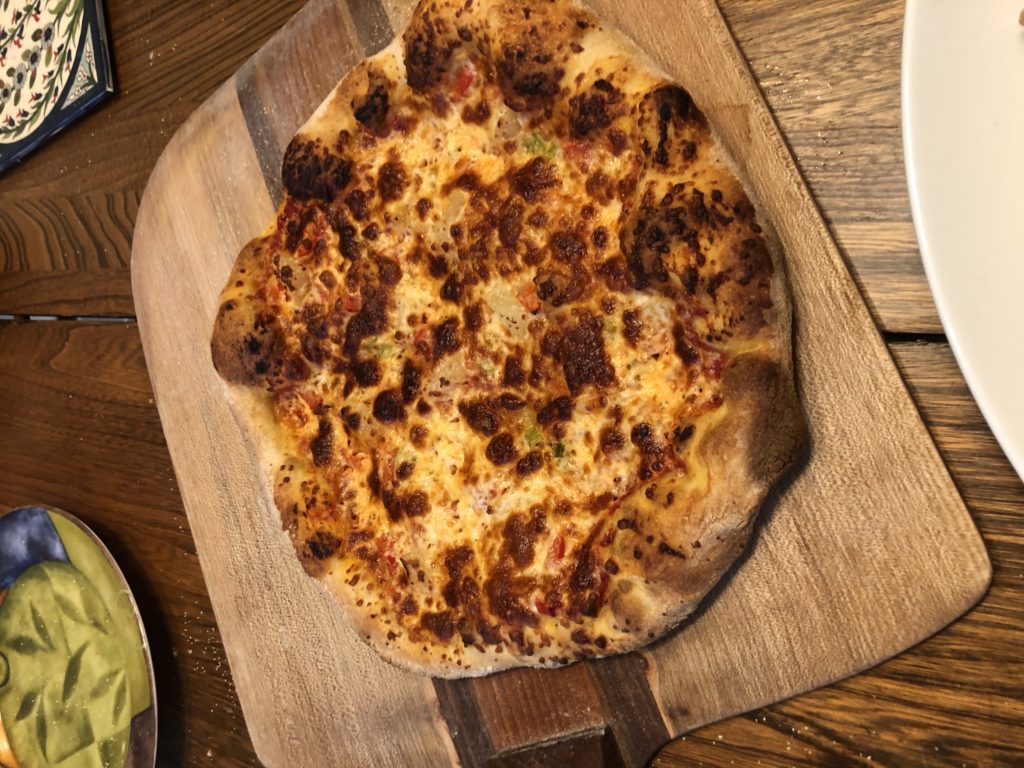Pizza, 2020 edition
Comments Off on Pizza, 2020 editionMay 31, 2020 by Jamie


Here’s how I make pizza, as of May 2020. I make the dough on Thursday morning and cook the pizza on Saturday evening. You need a pizza stone or steel or a fancy pizza oven, or find some analogue on the internet. You’ll probably want a pizza peel (paddle for moving pizza into the oven and out again); we use three— a pair of cheap ugly softwood ones for shuttling pizza crust around the kitchen as we prepare it for cooking and putting in the oven, and a fancy one (in the picture) for removing from the oven and presenting to the table. We’re pretty fucking fancy over here.
I use a 40 year old stand mixer with a dough hook, but you don’t need one if you don’t mind getting your hands dirty. You’ll need a liquid measuring cup, a mixing bowl, and a proofing bowl (can be the same bowl if you wash it) and some plastic wrap, and probably a baking sheet or storage container. You’ll want some good oven mitts.
You’ll probably want to re-write this recipe without my jokes.
Dough Ingredients:
- 10 oz of hot tap water (which is 284g)
- 1 tsp of active dry yeast
- could get by with less, haven’t experimented
- 2 tsp sugar
- will try with less with less yeast
- 420g of flour (~3 cups)
- high protein— e.g. bread flour, Canadian all purpose, or 00 flour. I prefer 00 flour but as of late 2020 have been back to all purpose lately and it’s fine.
- 1/2 tsp sea salt
- 2 tbsp extra virgin olive oil
- extra flour for making a mess
- olive oil for keeping fermenting dough unstuck
- corn meal for lubricating the uncooked pizza against the peel
Note:
The original recipe I followed was 2tsp yeast, 1tsp sugar – as my yeast got older and older I used more sugar to feed it, as well as increasing the amount of yeast— I loved the flavour, but as I made it further and further out (for more fermentation) from cooking, monster rising made me lower the amount again.
Instructions:
Fill your measuring cup with the hot tap water (or magical spring water or whatever), and assuming it’s not too hot for the yeast, dump in your yeast and sugar and whisk it together (if it is too hot— >54°C, 130°F, let it cool). Let this sit for 5-15 minutes to activate (beige stuff forms on top of the water). Meanwhile, put a cup of flour in the mixing bowl. Pour in the yeast/sugar/water mixture and whisk or mix together. I let this sit for 20 minutes. Add another cup of flour in, and after it’s mixed, mix in the extra-virgin olive oil. Add in the final cup of flour— if you using a stand mixer that doesn’t have a cover, you probably want to do this slowly or your beloved mixer will cover you flour. After it is mixed, you can let it sit some more for autolysing, or just continue on. I add the salt and then let my mixer knead for a while, so if you only have your hands, get to work. Occasionally I stop and knock it off the hook with a knife and check on it. Once it’s nice and elastic, I form it into a ball (look up a video on YouTube, I just learned about dropping the ugly side on a clean floured work surface to make a perfect ball). I then use the ball (and the non-virgin olive oil) to oil the proofing bowl. The bowl is then covered in plastic wrap and a tea towel and left on the counter for 20 minutes (and sometimes 40 by accident).
Put the covered bowl in the fridge, as is, and forget about it.
On Saturday morning, I take the dough out, and using a scale, divide it into four equal pieces, which I ball and then place on a floured baking sheet, and after flouring the top of the balls, cover each in a piece of plastic wrap and the tea towel (I use a decorative one that is terrible at absorbing water so no one in my family steals it to dry dishes or their hands). I leave this out for 20 minutes and then it goes into the fridge.
2 hours before cooking time, I take the dough out of the fridge and leave it on the counter to warm up, making it easier to work with. About 70-80 minutes out, I put my pizza stones into the oven to preheat. I use convection roast at 550°F (this is as hot as it goes without hacking the self clean function). It is important to put your cold pizza stones in a cold oven and for the stones to preheat for a long time, hence the timing. I have my oven racks in the middle and bottom positions, and if I only had one pizza stone it would go in the middle. The oven is going to be on at this temperature for 90 minutes, so hope you dressed in layers or have good blinds or a previously familiar relationship with your neighbours.
At this time, I also chop and salt my peppers— the salt draws moisture out of the peppers which I pour off before putting on the pizza and helps things from getting soggy.
As your preheat times comes to a close, clean and then pour a mess of flour on a work surface, it’s time to stretch the pizza dough. Flour up your hands and pick the biggest of the equal dough balls. If you like a big beautiful cornicione (the outer rim of crust), do not use a rolling pin— but more on that later.
Hand stretching:
Go watch a youtube video. Basically you pat the ball into more of a disc shape, and then using your fingers press a circle in about 1.25cm/0.5” in from the edge, and then press everything inwards from there. Then you use whatever method you can (gravity works wonders) to stretch the dough out to the right size without sticking a piece of your body through the dough.
Or, alternatively, the Rolling Pin:
This is how I used to do it. I like the large size and paper thin crust (it’s so thin it’s probably gluten free (don’t correct me on this)), but the cornicione isn’t satisfying. I will still do this if I screw up the hand stretch too badly. You’ll want to roll it out larger than your peel, and then once on the peel, roll the overhang back by hand in to make a cornicione. When rolling the dough out, flip and flour the dough often to prevent sticking.
Corn meal everywhere:
If you have a shitty oven that can’t go above the flash point of parchment paper (~420°F, but it should say on the box), you can use the much cleaner alternative of parchment paper for this step.
If you are lucky enough to have a nice hot oven and a vacuum cleaner or broom, you should instead cover your peel with a layer of corn meal and then put your stretched dough on it. If you hand stretched, you can try and stretch it out more at this point so it doesn’t look quite so small and awkward. If you rolled, now is the time to roll in the cornicione.
Topping
Take a fork and poke the area of the pizza dough that will be covered in sauce. Try not to go through the crust. This is called docking.
Cover in a thin layer of sauce, then top it. If you rolled the dough out, go super light on the toppings, it can’t take a lot. The hand stretched one is going to be more forgiving due to being thicker (so far for me, anyway).
You’ll want some low moisture mozzarella, frequently sold as “pizza mozzarella”. I use a food processor to grate this into powder (using the chopping blade, the grating blade is not good with soft cheeses).
Cooking
Make sure the pizza moves around on the peel with a little shake; you can apply emergency cornmeal with the help of a spatula. Once all the pizzas you’re going to be putting in the oven at once are free to move, put them on the stones. I start with the bottom one, and once they’re both in, I set a timer for 6 minutes. At that time, I take the top one out and dump it on a platter or cutting board, and then put the bottom one on the top stone for another minute to help brown the crust and cheese under the broiling element.
Cornmeal, Redux:
Once a stone is free of cooked pizza, using some very good oven mitts, I take it out of the oven and dump the corn meal off it onto/into something— clean up is later. At 550 freedom degrees it burns really quickly and smells amazingly bad— this wasn’t a problem at 450°F. Stone goes back in the oven.
Things to try:
Rack position: if I just had one stone, I think I would put it closer to the broiler element.
Pizza steel/aluminum: if I didn’t have a stone or wanted to part with $100, I would get a steel or thick aluminum cooking surface.
Both of the above are in the interest of cooking the pizza faster, which should leave the inside dough chewier.
I also want to try dividing the dough after the first 20 minute room temperature proof, and letting it ferment in the fridge in individual containers from Thursday morning to Saturday afternoon.
The Sauceror’s Apprentice
For the sauce, I throw the following into a blender:
- Can of tomatoes
- Small can of tomato paste
- 1 tbsp olive oil (actually, it’s “a glug”)
- 1 tbsp Sugar (might be two)
- a ton of dried basil
- garlic (actually a roasted garlic/pepper mix)
- oregano
- black pepper
- something a tiny bit spicy (have variously used: chilli powder, chilli flakes, a small amount of olive oil infused with habanero)
Then I blend it smooth and freeze it. I do not cook it.
Links
Here are some helpful videos (I’ve watched a lot more, but these are ones I thought of):
- Adam Ragusea’s New York-style pizza at home, v2.0
- Alex (French Guy Cooking)’s homemade pizza playlist
- self-cleaning oven pizza (don’t do this)
- pizza shaping
- J. Kenji López-Alt’s NY style pizza – in particular how he stretches the dough at 8:30
- Babish: NY style pizza – similar to the above, but in a home oven.
The last two links use a food processor instead of a stand mixer.
Revision History:
Late 2020:
- Since the summer I’m using 1/2 tsp of salt in the dough for more flavour, and I tend to add it to the remaining flour after mixing in the first cup, as I’ve forgotten it a few times if I leave it until later.
- I use extra-virgin olive oil anytime oil is called for (concerns about cooking with it are unfounded).
- Changed the note about the flour to use.
- I no longer flip the dough over when stretching— the bottom is the bottom always; reduces the amount of flour on the finished pizza.
Category Baking, Pizza | Tags:
Comments Off on Pizza, 2020 edition
Sorry, comments are closed.
